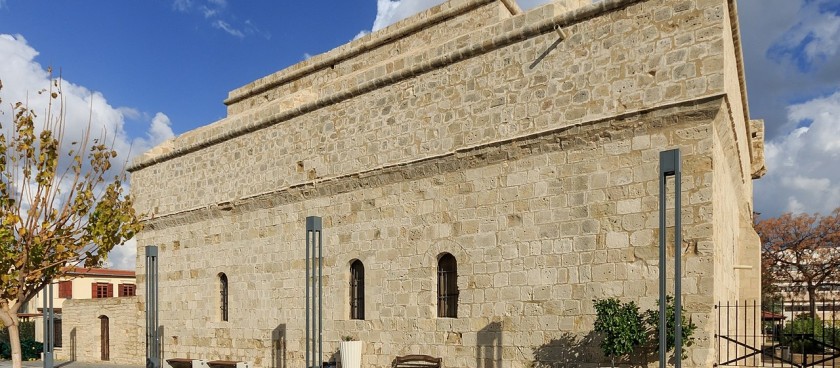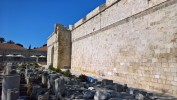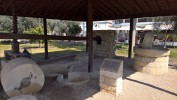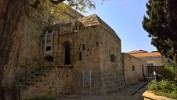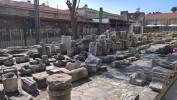- #CY33
- Ricardou and Berengarias, 1/1, Limassol
- +35725305419, +35725305157
- Working hours*:
Monday – Saturday 09:00 – 17:00
Sunday 10:00 – 13:00 - Prices*:
€4,5 (half-priced admission for children). - * - opening and closing times as well as entrance prices, are subject to alterations without notice. Visitors are advised to check before visiting.
- 34.6723450, 33.0416320 Copy to clipboard Copy
-
#Castles
The Limassol Castle, which dates back to the Middle Ages, is located in the Old Town quarters. For a long time its mission was to protect the island from foreign raids. According to different sources, including a testimony by Etienne de Lusignan, the castle was built by Guy de Lusignan in the 12th century (possibly in 1193), while records first mention its existence in 1228.
The castle lived through several periods of reconstruction. Its current version dates back to the Ottoman period of the 19th century. Its permanent exhibition includes different objects illustrating the history of Cyprus from antiquity until the last third of the 19th century. The interior features architectural and decorative elements from different time periods.
It would be a good idea to spend an hour or two exploring the castle, whose quarters were once used as a prison. With its somber and imposing presence, it will no doubt cast its spell on you.
History
The castle is one of Limassol’s main attractions. It is known as the former site of Agios Georgios — a Byzantine basilica (6th – 8th centuries) where on May 12th 1191 King Richard the Lionheart married Berengaria of Navarre, the daughter of king of Navarre. At the time the castle was part of a larger byzantine fortress (circa 10 – 11th centuries) and was located in its northern quarters.
The first mention of the castle in 1228 is a result of the involvement of Frederick II (1194 – 1250), the emperor of the Holy Roman Empire, in Cyprus’s affairs.
The castle’s most famous prisoner is thought to be King Henry I of Cyprus (1217 – 1253). His father, Hugo, died when the boy was only one year old. Henry was crowned at the age of 8 and took up the reins of government at the age of 15.
Over the course of 400 years (1193 – 1590) the fortress had suffered from numerous earthquakes (the most powerful of which happened in the period of 1222 – 1491) and pirate attacks. Even its own rulers ha tried to demolish the castleand yet despite this, it was always able to bounce back.
During the war with Genoa (1373 – 1374), the foreign army had almost completely destroyed the castle. Having lost the war, the Kingdom of Cyprus [a state created as a result of the Third Crusade that existed until 1489 – ed.] was obligated to pay substantial war reparations to Genoa and was unable to afford the cost of restoration.
Witness accounts state that towards the end of the 14th century the area was practically abandoned. At the beginning of the 15th century the castle was included in the renovation program initiated by the bishop of Limassol. The ruins of the city walls near Zig Zag Avenue were used as building blocks. The bishop also ordered a restoration of the ill-fated castle, which despite this was still destined for more hardship in 1402 and 1408 when the Genoese attacked again.
The restored fortress was supposed to withstand attacks by the Mamlukes — a knightly military caste in Egypt in the Middle Ages, which developed from the ranks of slave soldiers. In 1413 and 1422 the castle was attacked by their army and fleet and although it wasn’t conquered, it suffered substantial damages. Following that it was struck by an earthquake and then in 1425 it was captured by the Egyptians during another raid on the city.
In 1538 during the Venetian rule on the island, the castle was captured by the Turks. Then after gaining back control over the castle and the city Marco Antonio Bragadin, the Venetian governor and military commander (1523 – 1571), ordered the castle to be destroyed so as to avoid future raids on this strategically important building. Only parts of the castle were demolished, but then a series of earthquakes finished the job in the period of 1567 – 1568.
The Venetians later realized that Turkish attacks were unavoidable and decided to build a new fortress on the site of the previous one. Incidentally, Egorios Voustronios (a Greek writer and diplomat) had later criticized the governor’s decision to demolish the fortress, arguing that it would’ve been cheaper to restore it. After the Turkish finally captured the island (1576) they used the remains of the old fortress to build a citadel with two-meter thick walls and two stories of prison cells (1590). The British took over the citadel and beginning in 1878 and up until 1950 the castle was mainly used as a prison.
In the following years when control over all of the prisons in Cyprus was transferred to Nicosia, the Limassol Castle was designated as a historic monument and the Department of Antiquities proposed turning it into a local archeological museum. Following the period of upheaval between 1963 and 1974 the fortress remained closed to the public and was used as an exclave for the National Guard.
Following a period of reconstruction that included changes to the interior in order to create space for an exhibition the Cyprus Medieval Museum finally opened on March 28 1987.
The majority of the objects on display belong to another museum — the one in Nicosia, which is located in the buffer zone overseen by the UN peacekeeping forces.
Compared to its 1193 version, the present castle is smaller in size, but thanks to the more massive walls, it actually appears larger. Because of the many times the castle was destroyed and rebuilt, it features different architectural elements. The bottom two stories of the castle belong to the crusader period and are gothic in style.
The castle is surrounded by a park that houses an exhibition of archeological finds and artifacts, such as ceramics, a millstone, fragments of columns, etc. Take a look at the ancient oil press (Byzantine period 7th – 9th centuries), which includes special reservoirs for the storage of oil.
The Museum
The objects on display at the museum reflect Cyprus’s historic path beginning from antiquity. Visitors can explore the different economic stages of its development, its social and cultural past as well as the centuries-old traditions and rituals that shaped the island’s identity. The exhibition can be divided into four chronological periods:
Late antiquity, Early Christianity and Early Byzantium(324 – 650);
Middle and Post Byzantine period (650 – 1192), Dark Ages / Arab attacks (650 – 965), Late Byzantine period (965 – 1191);
Middle Ages (1192 – 1570), the French rule and the House of Lusignan (1192 – 1489), Venetian period (1489 – 1570);
Ottoman rule (1571 – 1878).
We enter the second floor of the castle via the stone staircase that runs through the watchtower (at one point the cannons in this watchtower were used to protect the main entrance).
In the center of the hall you will see a glass window case that displays antique ceramics and pottery, such as different types of vessels and lamps (most of which come from Salamis and the Chrysopolitissa Church in Kato Paphos).
